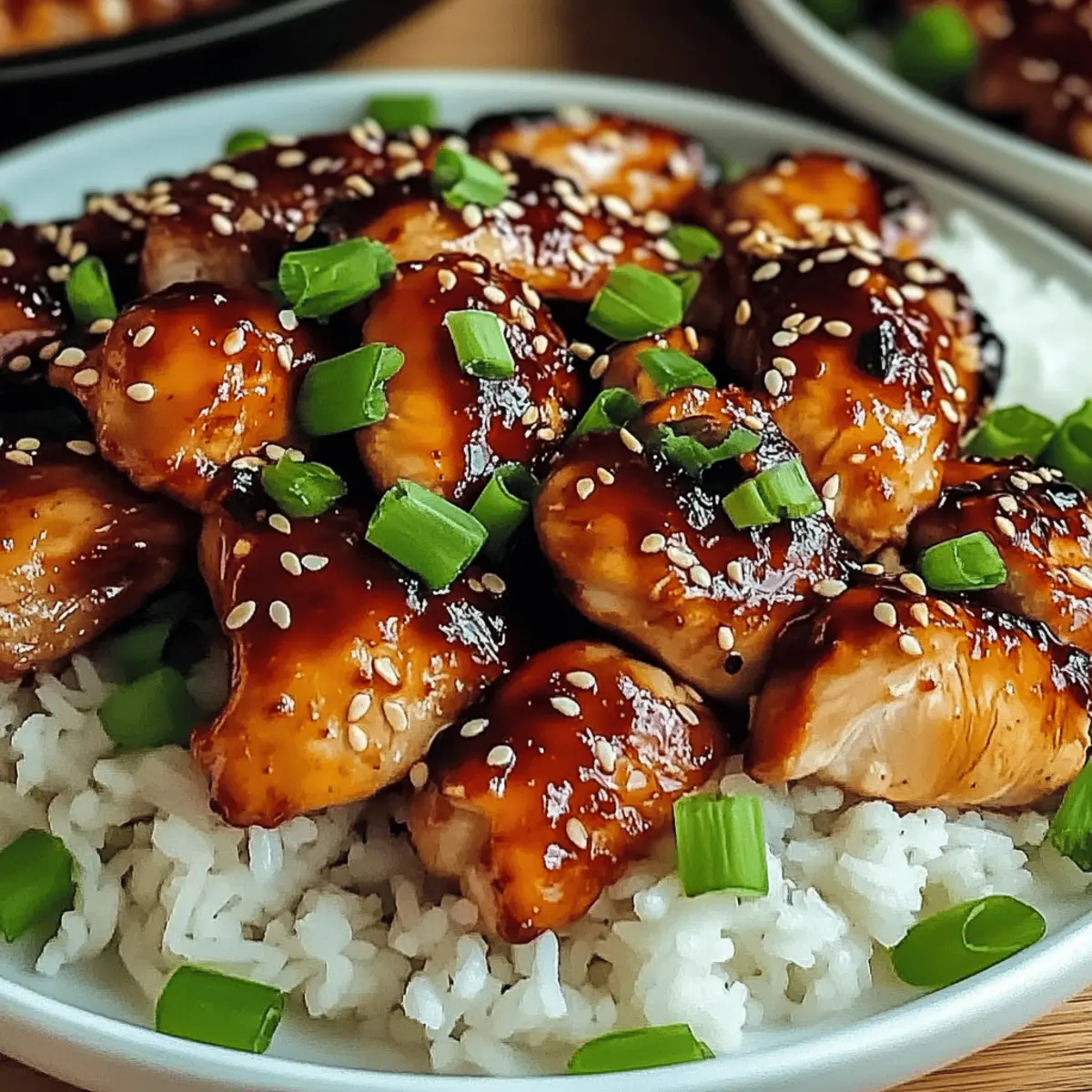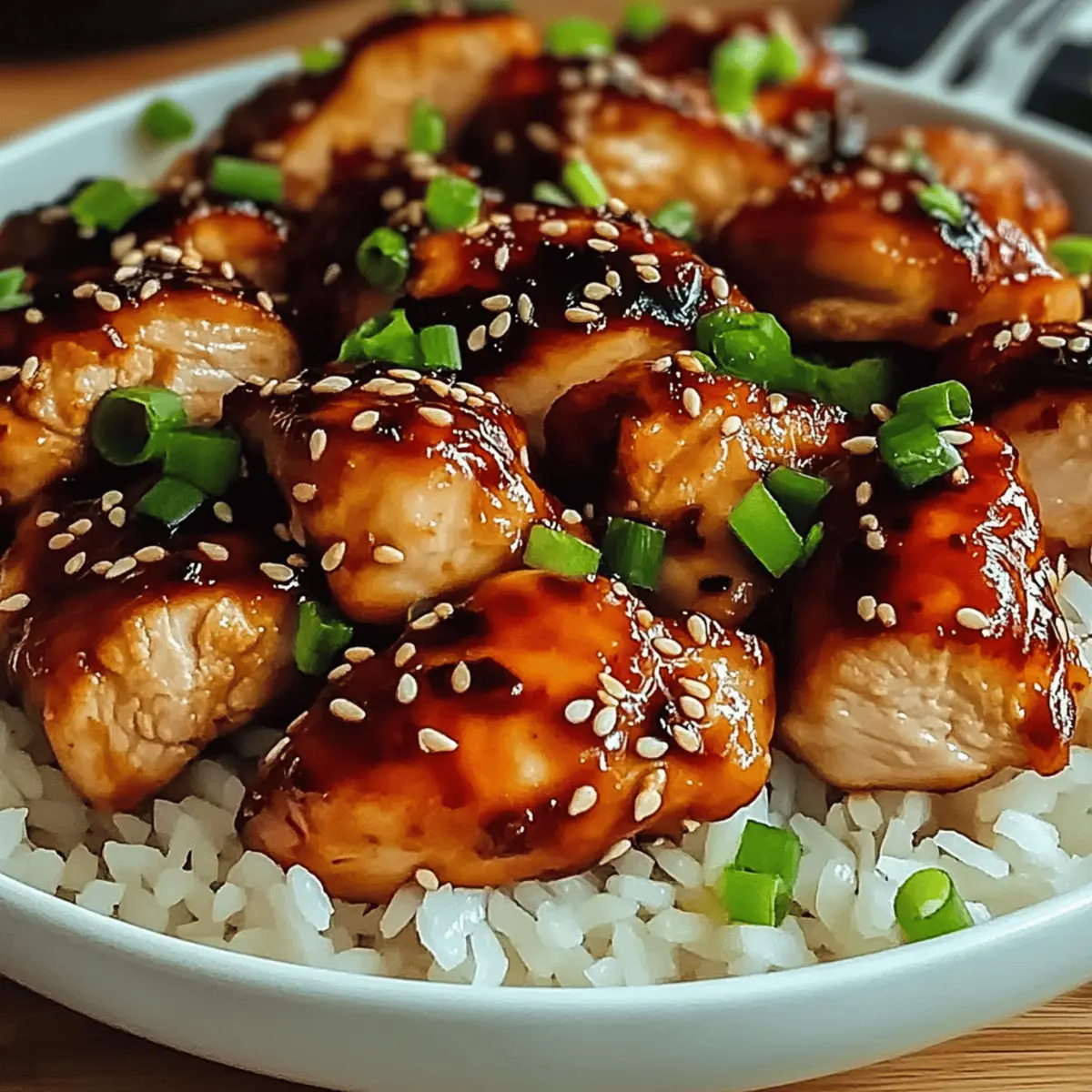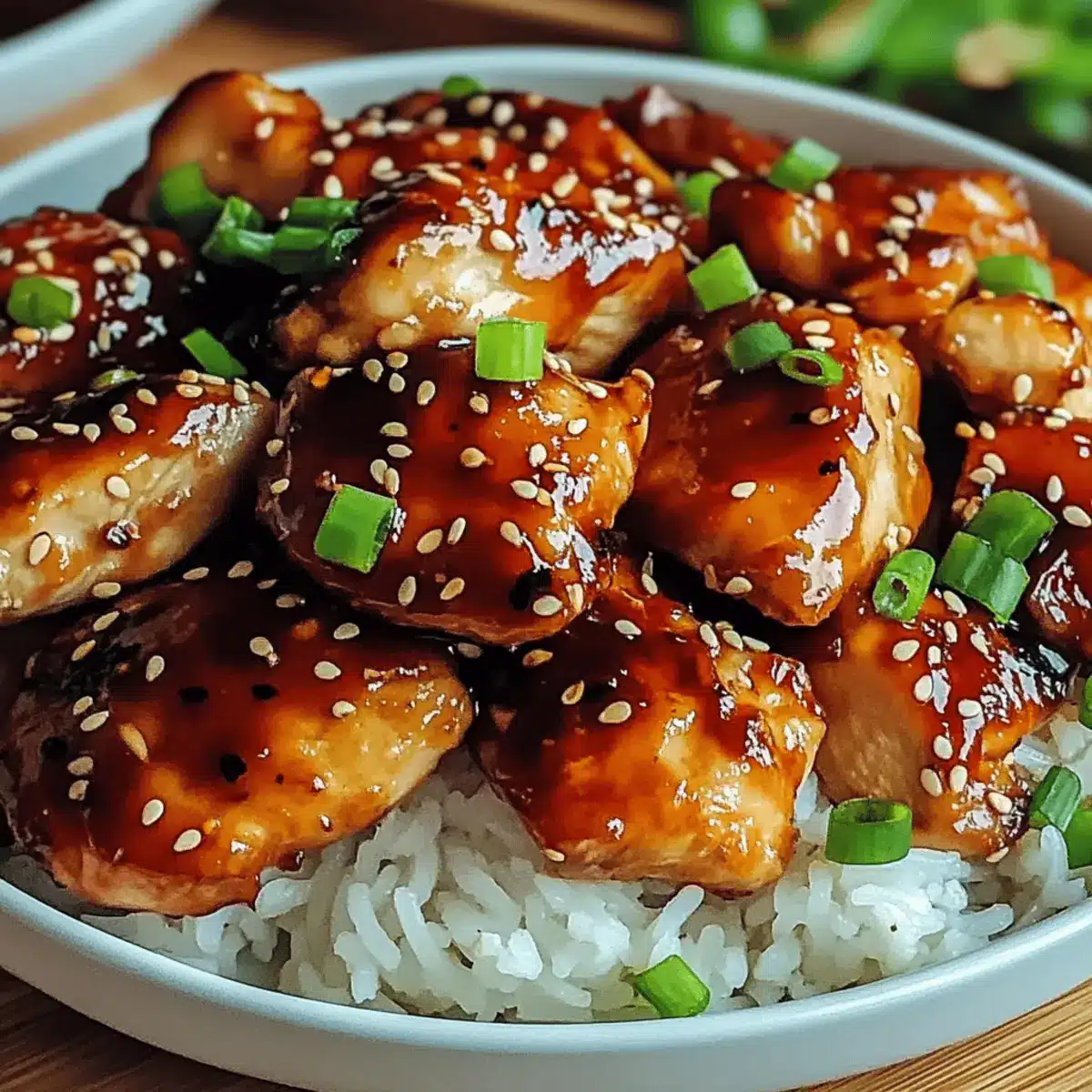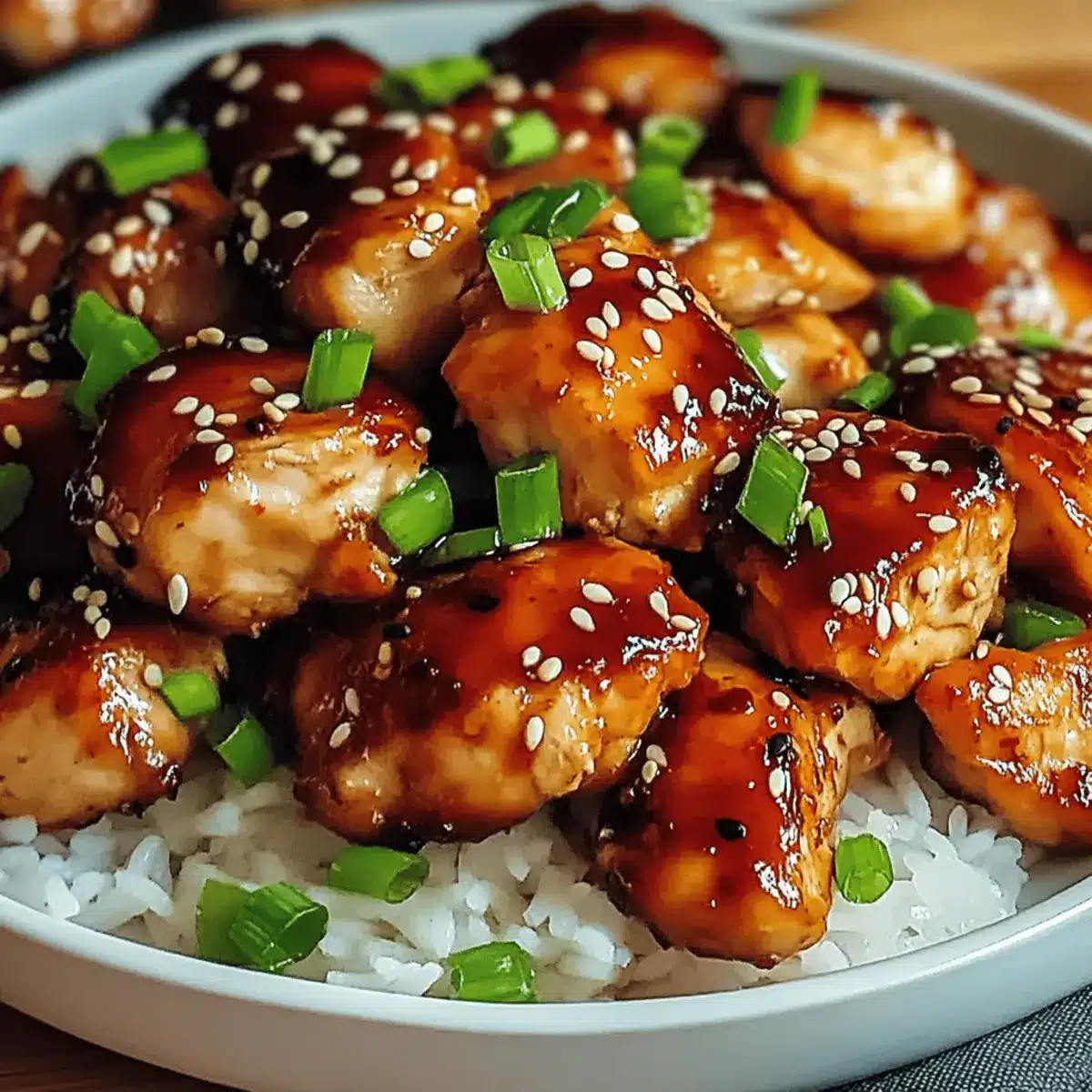As I stood in my kitchen one evening, the sizzle of chicken meeting a hot pan brought a smile to my face. I was preparing Korean Gochujang Chicken, a dish that transforms a regular weeknight meal into something special. This recipe is a spicy and slightly sweet marvel that’s both quick to whip up and endlessly adaptable to suit different cravings. Whether you’re padlocking children’s taste buds or craving a new flavor explosion, Gochujang sauce harmonizes everything beautifully. Plus, it offers a delightful opportunity to customize heat levels or toss in seasonal vegetables, making it a versatile winner in my kitchen. Ready to unlock the secrets of this zesty dish? Let’s dive in and discover the magic of Korean Gochujang Chicken together!

Why is Gochujang Chicken a Must-Try?
Flavor Explosion: Korean Gochujang Chicken delivers a tantalizing mix of spicy and sweet, making each bite a festival of flavors.
Quick and Easy: Perfect for busy nights, this dish can be on your table in just 30 minutes without compromising on taste.
Endless Variations: Cater to your cravings by easily modifying the spice levels or swapping in your favorite veggies. Want a sweet and sour twist? Add pineapple!
Crowd-Pleaser: Ideal for everyone, this dish appeals to kids and adults alike, making it an excellent choice for family dinners or gatherings. Pair it with sides like kimchi or serve it in wraps for added fun!
Impress with Simplicity: All you need is a handful of ingredients to create a gourmet-style meal right at home, rivaling any takeout option! So why not explore this delightful dish today?
Korean Gochujang Chicken Ingredients
• Here’s what you need!
For the Chicken
- Chicken Thighs or Breasts – Use skinless thighs for juiciness, or breasts for a leaner option.
For the Sauce
- Gochujang – This key ingredient adds distinct heat and flavor depth; adjust the quantity to modify spiciness.
- Honey – Balances spiciness and enhances caramelization; substitute with maple syrup for a different sweetness.
- Soy Sauce – Contributes saltiness and umami essence; use tamari for a gluten-free option.
- Sesame Oil – Adds nutty flavor; olive oil can work in a pinch.
For the Aromatics
- Garlic (minced) – Infuses fantastic flavor; fresh garlic is best, but powdered can be a shortcut.
- Fresh Ginger (grated) – Offers warming spice; ground ginger can replace fresh if necessary.
For Cooking
- Salt and Pepper – Essential to enhance the overall flavor; adjust to taste.
- Vegetable Oil – Used for sautéing; any neutral oil like canola works.
For the Veggies
- Onion (sliced) – Adds sweetness and texture when sautéed; shallots can be a milder alternative.
- Bell Pepper (any color, sliced) – Contributes crunch and color; feel free to mix in other vegetables like carrots.
- Green Onions (chopped) – For a fresh garnish; chives can be used as a substitute.
For Garnish
- Sesame Seeds – Adds crunch and visual appeal, although optional, they’re highly recommended!
With these ingredients, you’ll be all set to whip up a fantastic Korean Gochujang Chicken that will leave everyone raving!
Step‑by‑Step Instructions for Korean Gochujang Chicken
Step 1: Marinate the Chicken
In a bowl, combine gochujang, honey, soy sauce, sesame oil, minced garlic, grated ginger, salt, and pepper. Mix well until you create a smooth marinade. Add the chicken thighs or breasts, ensuring they are fully coated. Cover the bowl and let the chicken marinate in the refrigerator for at least 10 minutes, but if you have the time, opt for up to 2 hours for richer flavor.
Step 2: Heat the Oil
While the chicken marinates, heat 2 tablespoons of vegetable oil in a large skillet or wok over medium-high heat. After about 2 minutes, the oil should shimmer. This indicates it’s ready for cooking. Prepare your vegetables by slicing the onion and bell pepper, so they’re ready to toss in once the oil is heated.
Step 3: Sauté the Vegetables
Add the sliced onion and bell pepper to the hot oil, sautéing them for 3-4 minutes. Stir frequently until the vegetables soften and the onion becomes translucent. The vibrant colors and fragrant aromas will fill your kitchen! Once done, remove the vegetables from the skillet and set them aside on a plate while you prepare the chicken.
Step 4: Cook the Chicken
Using the same skillet, add the marinated chicken, allowing it to cook for 5-7 minutes. Stir occasionally, ensuring each piece is browned and cooked through. The internal temperature of the chicken should reach 165°F to ensure it’s fully cooked. You’ll know it’s ready when it takes on a beautiful golden color and the edges caramelize slightly.
Step 5: Combine Ingredients
Return the sautéed vegetables to the skillet with the cooked chicken, mixing everything well. Allow the mixture to cook together for an additional 2-3 minutes. This step helps meld all those delightful flavors of the Korean Gochujang Chicken, creating a harmonious and enticing dish that makes your mouth water.
Step 6: Garnish & Serve
Sprinkle chopped green onions and sesame seeds on top of the dish for a fresh pop of color and crunch. Serve your Korean Gochujang Chicken hot, either over rice or wrapped in lettuce for a light yet flavorful meal. The enticing aroma and vibrant colors will make it impossible to resist digging in right away!

Make Ahead Options
Korean Gochujang Chicken is a fantastic choice for meal prep, allowing you to save precious time during busy weeknights! You can marinate the chicken up to 24 hours in advance, infusing it with delightful flavors while ensuring optimal tenderness. Simply mix the marinade, coat the chicken, and store it in an airtight container in the refrigerator. Additionally, you can chop the vegetables (like onion and bell pepper) and refrigerate them for up to 3 days to streamline your cooking process. When you’re ready to cook, heat the skillet and follow the final steps to sauté the chicken and veggies together, delivering a delicious, hassle-free meal that’s just as flavorful as when made fresh!
What to Serve with Korean Gochujang Chicken
Enhance your meal experience with delicious and complementary side dishes that harmonize beautifully with this vibrant chicken dish.
-
Steamed Jasmine Rice: Fluffy rice soaks up the rich sauce, creating a perfect balance of flavors in each bite.
-
Crisp Lettuce Wraps: Light and refreshing, these wraps provide a crunchy texture that elevates the satisfying umami of the chicken.
-
Savory Kimchi: Traditionally Korean, the fermented vegetables add a spicy tang that brightens the dish, offering a wonderful counterpoint to the richness.
-
Pickled Vegetables: Tangy pickles offer a delightful crunch and acidity, helping to cleanse the palate between bites of the creamy gochujang sauce.
-
Sesame Noodles: Soft noodles tossed in sesame oil and sprinkled with green onions create a nutty, complementary side that feels comforting and hearty.
-
Spicy Cucumber Salad: This crisp salad adds a refreshing kick, contrasting the warming heat of the dish while being incredibly easy to prepare.
-
Cold Beer or Soju: A chilled drink pairs well with the spicy chicken, helping to mellow the flavors and enhance the overall dining experience.
-
Mango Sticky Rice: For dessert, this sweet treat is a delightful way to finish the meal, balancing the spicy notes with a tropical sweetness.
By combining these sides with your Korean Gochujang Chicken, you’ll create a colorful feast that tantalizes all the senses and delights your guests!
Expert Tips for Korean Gochujang Chicken
• Choose the Right Chicken: Use skinless chicken thighs for a juicier, flavorful dish. Breasts can dry out if overcooked, so monitor closely.
• Marinate Longer: Don’t rush the marinating process. Allowing the chicken to soak in the gochujang mixture for up to 2 hours deepens flavor immensely.
• Fire Up the Heat: Make sure your skillet is hot enough before adding the chicken. This helps achieve a nice sear and keeps the meat juicy.
• Fresh Ingredients Matter: Fresh garlic and ginger provide a more authentic taste than powdered versions, enhancing the overall flavor of your Korean Gochujang Chicken.
• Adjust Spice Levels: If you’re cooking for kids or those averse to heat, start with less gochujang and taste as you go. You can always add more!
• Experiment with Veggies: Don’t hesitate to add a variety of vegetables to the sauté mix. Carrots, zucchini, or snap peas can enhance the color and nutrition!
How to Store and Freeze Korean Gochujang Chicken
Fridge: Store leftovers in an airtight container in the refrigerator for 3-4 days. Ensure the dish cools completely before sealing to maintain freshness.
Freezer: For longer storage, freeze Korean Gochujang Chicken in a freezer-safe container or heavy-duty bag for up to 2 months. Thaw in the fridge overnight before reheating.
Reheating: To reheat, warm in a skillet over medium heat until heated through. You can add a splash of water or broth to keep it moist.
Wrapping: If making a wrap with leftovers, store filling separately to keep tortillas fresh and prevent sogginess.
Korean Gochujang Chicken Variations
Feel free to unleash your creativity and customize this delicious dish to suit your taste buds and pantry!
-
Sweet and Sour: Add pineapple chunks during cooking for a delightful tangy burst that complements the heat.
-
Extra Spicy: Incorporate sliced jalapeños or increase the gochugaru for an electrifying heat that’ll set your taste buds dancing.
-
Saucy Delight: Increase the honey and soy sauce for a thicker glaze, perfect for slathering over rice.
-
Vegetarian Twist: Substitute chicken with marinated tofu or tempeh, using the same cooking method for a plant-based version.
-
Wrap It Up: Use the chicken as a filling for tacos or burritos, pairing with fresh salsa and avocado for an extra flavor punch.
-
Crunchy Add-ins: Toss in some chopped peanuts or almonds at the end for a satisfying crunch and a touch of nutty flavor.
-
Fresh Herb Boost: Add a sprinkle of fresh cilantro or mint at the end for a refreshing twist that brightens up the dish.
For more delectable options, consider trying Garlic Parmesan Chicken or tossing leftovers into a One Pan Chicken recipe for a delightful spin!

Korean Gochujang Chicken Recipe FAQs
What type of chicken should I use for Korean Gochujang Chicken?
For the best results, I recommend using skinless chicken thighs as they tend to stay juicier and more flavorful. However, if you prefer a leaner option, skinless chicken breasts can be used as well—just be mindful not to overcook them, or they might dry out.
How do I store leftovers from Korean Gochujang Chicken?
Leftovers can be stored in an airtight container in the refrigerator for 3-4 days. Make sure the dish has cooled completely before sealing, which helps maintain freshness and flavor.
Can I freeze Korean Gochujang Chicken?
Absolutely! You can freeze the dish in a freezer-safe container or heavy-duty bag for up to 2 months. To thaw, simply place it in the refrigerator overnight. When ready to reheat, warm it in a skillet over medium heat until heated through, adding a splash of water or broth to maintain moisture.
What are some common troubleshooting tips for making Korean Gochujang Chicken?
If your chicken turns out dry, it’s likely due to overcooking. Monitor the cooking time closely, ensuring the internal temperature reaches 165°F. For added moisture, consider increasing the quantity of sauce during cooking. Also, if you find it too spicy, you can balance the heat by adding a bit more honey or serving it over rice to mellow the flavors.
Is Korean Gochujang Chicken suitable for dietary restrictions?
While this dish is delicious, it is not inherently gluten-free due to the soy sauce. If you’re accommodating gluten-free diets, simply substitute soy sauce with tamari. Always ensure that all other ingredients are compliant with any allergies or dietary needs you might have!

Korean Gochujang Chicken: Spice Up Your Weeknight Dinner!
Ingredients
Equipment
Method
- In a bowl, combine gochujang, honey, soy sauce, sesame oil, minced garlic, grated ginger, salt, and pepper. Mix well until smooth. Add chicken, coat thoroughly, and marinate for at least 10 minutes (up to 2 hours for richer flavor).
- Heat vegetable oil in a skillet over medium-high heat until shimmering (about 2 minutes). Prepare vegetables by slicing onion and bell pepper.
- Add onion and bell pepper to the hot oil, sauté for 3-4 minutes until softened and onion is translucent. Remove and set aside.
- In the same skillet, add marinated chicken and cook for 5-7 minutes, stirring occasionally until browned and cooked through. Ensure the internal temperature reaches 165°F.
- Return sautéed vegetables to the skillet, mixing everything well, and cook for an additional 2-3 minutes to meld flavors.
- Garnish with chopped green onions and sesame seeds. Serve hot over rice or wrapped in lettuce.

Leave a Reply